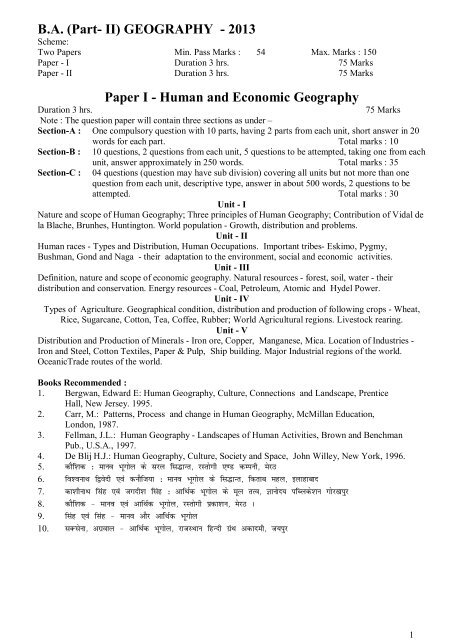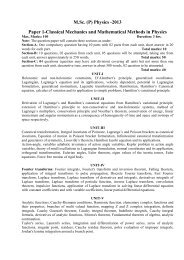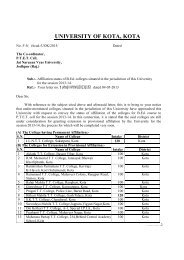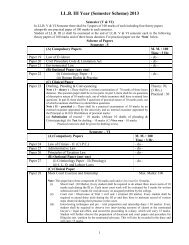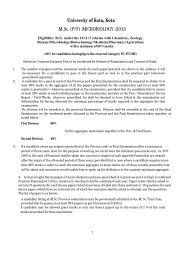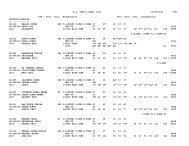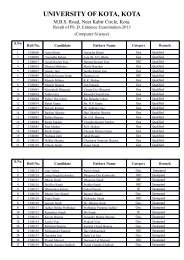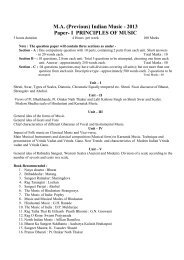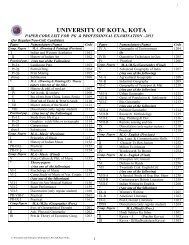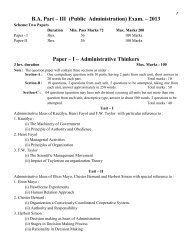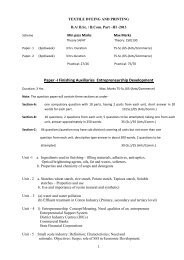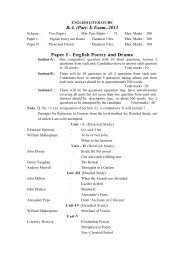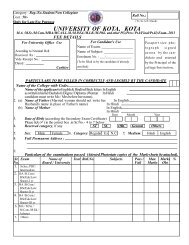B.A. (Part- II) GEOGRAPHY - 2013 Paper I - Human and Economic ...
B.A. (Part- II) GEOGRAPHY - 2013 Paper I - Human and Economic ...
B.A. (Part- II) GEOGRAPHY - 2013 Paper I - Human and Economic ...
You also want an ePaper? Increase the reach of your titles
YUMPU automatically turns print PDFs into web optimized ePapers that Google loves.
1<br />
B.A. (<strong>Part</strong>- <strong>II</strong>) <strong>GEOGRAPHY</strong> - <strong>2013</strong><br />
Scheme:<br />
Two <strong>Paper</strong>s Min. Pass Marks : 54 Max. Marks : 150<br />
<strong>Paper</strong> - I Duration 3 hrs. 75 Marks<br />
<strong>Paper</strong> - <strong>II</strong> Duration 3 hrs. 75 Marks<br />
<strong>Paper</strong> I - <strong>Human</strong> <strong>and</strong> <strong>Economic</strong> Geography<br />
Duration 3 hrs.<br />
75 Marks<br />
Note : The question paper will contain three sections as under –<br />
Section-A : One compulsory question with 10 parts, having 2 parts from each unit, short answer in 20<br />
words for each part. Total marks : 10<br />
Section-B : 10 questions, 2 questions from each unit, 5 questions to be attempted, taking one from each<br />
unit, answer approximately in 250 words. Total marks : 35<br />
Section-C : 04 questions (question may have sub division) covering all units but not more than one<br />
question from each unit, descriptive type, answer in about 500 words, 2 questions to be<br />
attempted. Total marks : 30<br />
Unit - I<br />
Nature <strong>and</strong> scope of <strong>Human</strong> Geography; Three principles of <strong>Human</strong> Geography; Contribution of Vidal de<br />
la Blache, Brunhes, Huntington. World population - Growth, distribution <strong>and</strong> problems.<br />
Unit - <strong>II</strong><br />
<strong>Human</strong> races - Types <strong>and</strong> Distribution, <strong>Human</strong> Occupations. Important tribes- Eskimo, Pygmy,<br />
Bushman, Gond <strong>and</strong> Naga - their adaptation to the environment, social <strong>and</strong> economic activities.<br />
Unit - <strong>II</strong>I<br />
Definition, nature <strong>and</strong> scope of economic geography. Natural resources - forest, soil, water - their<br />
distribution <strong>and</strong> conservation. Energy resources - Coal, Petroleum, Atomic <strong>and</strong> Hydel Power.<br />
Unit - IV<br />
Types of Agriculture. Geographical condition, distribution <strong>and</strong> production of following crops - Wheat,<br />
Rice, Sugarcane, Cotton, Tea, Coffee, Rubber; World Agricultural regions. Livestock rearing.<br />
Unit - V<br />
Distribution <strong>and</strong> Production of Minerals - Iron ore, Copper, Manganese, Mica. Location of Industries -<br />
Iron <strong>and</strong> Steel, Cotton Textiles, <strong>Paper</strong> & Pulp, Ship building. Major Industrial regions of the world.<br />
OceanicTrade routes of the world.<br />
Books Recommended :<br />
1. Bergwan, Edward E: <strong>Human</strong> Geography, Culture, Connections <strong>and</strong> L<strong>and</strong>scape, Prentice<br />
Hall, New Jersey. 1995.<br />
2. Carr, M.: Patterns, Process <strong>and</strong> change in <strong>Human</strong> Geography, McMillan Education,<br />
London, 1987.<br />
3. Fellman, J.L.: <strong>Human</strong> Geography - L<strong>and</strong>scapes of <strong>Human</strong> Activities, Brown <strong>and</strong> Benchman<br />
Pub., U.S.A., 1997.<br />
4. De Blij H.J.: <strong>Human</strong> Geography, Culture, Society <strong>and</strong> Space, John Willey, New York, 1996.<br />
5. dkSf'kd % ekuo Hkwxksy ds ljy fl)kUr] jLrksxh ,.M dEiuh] esjB<br />
6. fo'oukFk f}osnh ,oa dukSft;k % ekuo Hkwxksy ds fl)kUr] fdrkc egy] bykgkckn<br />
7. dk'khukFk flag ,oa txnh'k flag % vkfFkZd Hkwxksy ds ewy rRo] Kkuksn; ifCyds'ku xksj[kiqj<br />
8. dkSf'kd & ekuo ,oa vkfFkZd Hkwxksy] jLrksxh izdk'ku] esjB A<br />
9. flag ,oa flag & ekuo vkSj vkfZFkZd Hkwxksy<br />
10. lDlsuk] vxzoky & vkfFkZd Hkwxksy] jktLFkku fgUnh xzaFk vdkneh] t;iqj
2<br />
<strong>Paper</strong> <strong>II</strong> - Geography of Rajasthan<br />
Duration 3 hrs.<br />
75 Marks<br />
Note : The question paper will contain three sections as under –<br />
Section-A : One compulsory question with 10 parts, having 2 parts from each unit, short answer in 20<br />
words for each part. Total marks : 10<br />
Section-B : 10 questions, 2 questions from each unit, 5 questions to be attempted, taking one from each<br />
unit, answer approximately in 250 words. Total marks : 35<br />
Section-C : 04 questions (question may have sub division) covering all units but not more than one<br />
question from each unit, descriptive type, answer in about 500 words, 2 questions to be<br />
attempted. Total marks : 30<br />
Unit - I<br />
Introduction: Formation <strong>and</strong> administrative setting of the State, Geological structure, Relief,<br />
Physiographic regions, Drainage, Climate, Soils, Natural vegetation.<br />
Unit - <strong>II</strong><br />
Agricultural aspects of the State, Food <strong>and</strong> commercial crops, Major irrigation sources, types <strong>and</strong> their<br />
intensity, Wastel<strong>and</strong>, Desertification <strong>and</strong> Desert development programmes. Live stock <strong>and</strong> dairy<br />
development.<br />
Unit - <strong>II</strong>I<br />
Power <strong>and</strong> energy resources, Hydal, Thermal, Atomic, Solar, Wind, Biogas, Mineral resources &<br />
Industries.<br />
Unit - IV<br />
Demographic structure, growth, distribution, density urban-rural occupational structure, literacy. Cultural<br />
heritage - Tourism, Fairs <strong>and</strong> Festivals. Tribes of Rajasthan - Bhils, Saharia <strong>and</strong> Grarasia. Transportation<br />
<strong>and</strong> Trade.<br />
Unit - V<br />
Geographical regions of Rajasthan, Detailed study of Marusthali, Aravalli, Hadoti, Eastern plain.<br />
Environmental problems-Water, Soil, Air <strong>and</strong> Mining. Conservation <strong>and</strong> management of forest, water<br />
<strong>and</strong> soil. National Parks <strong>and</strong> Wildlife Sanctuaries.<br />
Books Recommended :<br />
1. pkSgku oh- ,l-% jktLFkku dk Hkwxksy] foKku izdk'ku] tks/kiqj<br />
2. HkYyk ,y- vkj-% jktLFkku dk Hkwxksy] dqynhi izdk'ku<br />
3. ,p- ,e- lDlsuk%jktLFkku dk Hkwxksy] jktLFkku fgUnh xzUFk vdkneh] t;iqj<br />
4. ,p- ,l- 'kekZ% jktLFkku dk Hkwxksy] iap'khy izdk'ku] t;iqj<br />
5. Mishra V.C.: Geography of Rajasthan, N.B.T., Delhi<br />
6. Sharma H.S. <strong>and</strong> Sharma M. L.: Geographical facts of Rajasthan.<br />
<strong>GEOGRAPHY</strong> PRACTICAL<br />
Scheme only for Regular& Ex.- Students :<br />
Practicals Min. Pass Marks - 18 Max. Marks- 50<br />
1. Lab. Work 2 hrs 18 Marks<br />
(written paper - Three out of 5 questions to be attempted)<br />
2. Field Survey <strong>and</strong> Viva-Voce 2 hrs 8+4=12<br />
3. Record work <strong>and</strong> Viva-Voce 1 hr 8+4=12<br />
4. Project report <strong>and</strong> Viva-Voce 1 hr 6+2=08<br />
Note: Record work should be prepared on practical work book.<br />
Total 50<br />
Duration - 6 hrs of each batch of 20 students
3<br />
Scheme only for Non-Collegiate C<strong>and</strong>idates:<br />
Practicals Min. Pass Marks - 18 Max. Marks- 50<br />
1. Lab. Work 2 hrs 24 Marks<br />
(written paper - Three out of 5 questions to be attempted)<br />
2. Field Survey <strong>and</strong> Viva-Voce 2 hrs 8+4=12<br />
3. Record work <strong>and</strong> Viva-Voce 1 hr 10+4=14<br />
Note: Record work should be prepared on practical work book.<br />
Total 50<br />
Duration - 6 hrs of each batch of 20 students<br />
Contents :<br />
1. Types of cartographic symbols <strong>and</strong> their uses-point, line <strong>and</strong> area symbols.<br />
2. Classification of distribution maps- quantitative <strong>and</strong> qualitative.<br />
3. Diagrams :<br />
(a) One dimensional- bars, pyramids,<br />
(b) Two dimensional – wheel, circle, square, rectangular,<br />
(c) Three dimensional - sphere <strong>and</strong> cubes.<br />
4. Quartile, mean, deviation <strong>and</strong> st<strong>and</strong>ard deviation.<br />
5. Study <strong>and</strong> interpretation of Indian Topographical sheets.<br />
6. Plane table survey - radiation <strong>and</strong> intersection methods.<br />
7. Socio-<strong>Economic</strong> survey of any village (only for regualr students) (report in 10 to 15 pages only)<br />
Books Recommended :<br />
1. Monkhouse, F.J. : Maps <strong>and</strong> Diagrams, Methuen Co., London.<br />
2. Robinson, A.H.: Elements of Cartography, John Willey & Sons, New York.<br />
3. Mishra, R.P. : Fundamentals of Cartography, McMillan, New Delhi.<br />
4. ts- ih-‘'kekZ % izk;ksfxd Hkwxksy&jLrksxh izdk'ku] esjB<br />
5- ,e-,l- tSu % iz;ksxkRed Hkwxksy&lkfgR; Hkou] vkxjk<br />
ch-,-&Hkkx &f}rh; ijh{kk &<strong>2013</strong><br />
izFke iz'u i= &ekuo ,oa vkfFkZd Hkwxksy<br />
vof/k & 3 kaVs iw.kkZad& 75<br />
uksV % bl iz'u i= esa 03 [k.M fuEu izdkj gksaxsa %<br />
[k.M v<br />
bl [k.M esa ,d vfuok;Z iz'u ftlesa izR;sd bdkbZ ls 02 ykq iz'u ysrs gq, dqy 10 iz'u gksaxsaA izR;sd<br />
ykq iz'u dk mÙkj yxHkx 20 'kCnksa esa gksA dqy vad & 10<br />
[k.M c<br />
bl [k.M esa izR;sd bdkbZ ls 2 iz'u ysrs gq, dqy 10 iz'u gksaxsA izR;sd bdkbZ esa ls ,d iz'u dk p;u<br />
djrs gq, dqy 5 iz'u djus gkasxsA izR;sd iz'u dk mÙkj yxHkx 250 'kCnksa esa gksA dqy vad & 35<br />
[k.M l<br />
bl [k.M esa 4 iz'u o.kZukRed gksaxsA ¼iz'u esa Hkkx Hkh gks ldrs gSa½ tks lHkh bdkbZ;ksa esa ls fn;s tk;saxs<br />
fdUrq izR;sd bdkbZ ls ,d ls vf/kd iz'u ugha gksxkA 2 iz'uksa ds mÙkj fn;s tkus gSaA izR;sd iz'u dk mÙkj<br />
yxHkx 500 'kCnksa esa gksA dqy vad & 30<br />
bdkbZ &1<br />
ekuo Hkwxksy dh izd`fr] fo"k; oLrq rFkk ekuo Hkwxksy ds rhu fl)kUr] ekuo Hkwxksy esa okbZMy Mh- yk-<br />
Cyk'k] czwUl rFkk gafVaxVu dk ;ksxnku] fo'o tula[;k & o`f)] forj.k ,oa leL;k;saA<br />
bdkbZ & 2
4<br />
ekuo iztkfr;kW &izdkj ,oa forj.k] ekuo O;olk; A egRoiw.kZ tutkfr;k¡& ,fLdeks] fiXeh] cq'keSu] xksUM<br />
rFkk ukxk dh lkekftd ,oa vkfFkZd xfrfof/k;ka rFkk i;kZoj.k lek;kstuA<br />
bdkbZ &3<br />
vkfFkZd Hkwxksy dh ifjHkk"kk] izd`fr ,oa fo"k; oLrq A izkd`frd lalk/ku &ou] eǹk] ty ,oa mudk forj.k<br />
,oa laj{k.k] & 'kfDr lalk/ku & dks;yk] isVªksfy;e] ty 'kfDr] v.kq 'kfDr A<br />
bdkbZ &4<br />
d`f"k ds izdkj] fuEu Qlyksa dh HkkSxksfyd n'kk;sa] forj.k ,oa mRiknu & xsgaw] pkoy] xUuk] dikl] pk;]<br />
dkWQh ,oa jcj] fo'o d`f"k izns'k] i'kqikyu A<br />
bdkbZ & 5<br />
[kfutksa dk forj.k ,oa mRiknu& yksg v;Ld] rkack] eSaXkuht] vHkzd] m|ksxkas dh vofLFkfr & ykSg bLikr]<br />
lwrh oL=] yqXnh ,oa dkxt] tgkt fuekZ.k] fo'o ds izeq[k vkS|ksfxd izns'k] fo'o ds lkeqfnzd O;kikfjd<br />
ekxZA<br />
f}rh; iz'u i=&jktLFkku dk Hkwxksy<br />
vof/k & 3 kaVs iw.kkZad& 75<br />
uksV % bl iz'u i= esa 03 [k.M fuEu izdkj gksaxsa %<br />
[k.M v<br />
bl [k.M esa ,d vfuok;Z iz'u ftlesa izR;sd bdkbZ ls 02 ykq iz'u ysrs gq, dqy 10 iz'u gksaxsaA izR;sd<br />
ykq iz'u dk mÙkj yxHkx 20 'kCnksa esa gksA dqy vad & 10<br />
[k.M c<br />
bl [k.M esa izR;sd bdkbZ ls 2 iz'u ysrs gq, dqy 10 iz'u gksaxsA izR;sd bdkbZ esa ls ,d iz'u dk p;u<br />
djrs gq, dqy 5 iz'u djus gksaxsA izR;sd iz'u dk mÙkj yxHkx 250 'kCnksa esa gksA dqy vad & 35<br />
[k.M l<br />
bl [k.M esa 4 iz'u o.kZukRed gksaxsA ¼iz'u esa Hkkx Hkh gks ldrs gSa½ tks lHkh bdkbZ;ksa esa ls fn;s tk;saxs<br />
fdUrq izR;sd bdkbZ ls ,d ls vf/kd iz'u ugha gksxkA 2 iz'uksa ds mÙkj fn;s tkus gSaA izR;sd iz'u dk mÙkj<br />
yxHkx 500 'kCnksa esa gksA dqy vad & 30<br />
bdkbZ &1<br />
izLrkouk o jktLFkku dk fuekZ.k] iz'kkldh;
5<br />
jktLFkku ds HkkSxksfyd izns'k&e:LFkyh] vjkoyh] gkM+kSrh] iwohZ eSnku dk foLr`r v/;;uA i;kZoj.kh;<br />
leL;k;sa&ty] ok;q] feV~Vh ,oa [kuuAou] ty ,oa feV~Vh lalk/kuksa dk laj{k.k ,oa izcU/kuA jk"Vªh; m|ku<br />
,oa oU;tho vH;kj.;A<br />
izk;ksfxd Hkwxksy ¼dsoy fu;fer o iwoZ fo|kfFkZ;ksa gsrq½<br />
iw.kkZad& 50<br />
1- iz;ksx'kkyk dk;Z ¼fyf[kr iz'u i= nks k.Vs dh vof/k½ 18 vad<br />
¼ikWp iz'uksa esa ls ijh{kkFkhZ dks rhu iz'u djus gksxsa½<br />
2- {ks= losZ{k.k vkSj ekSf[kd ¼nks k.Vs½ 08$04 12 vad<br />
3- vfHkys[k dk;Z vkSj ekSf[kd ¼,d k.Vs½ 08$04 12 vad<br />
4- losZ{k.k izfrosnu rFkk ekSf[kd ¼,d k.Vs½ 06$02 8 vad<br />
uksV% vfHkys[k dk;Z Hkwxksy ch-,- Hkkx&f}rh; dh fu/kkZfjr vH;kl iqfLrdk ij fd;k tkosxkA<br />
;ksx 50 vad<br />
dkyka'k & 20 fo|kfFkZ;ksa ds izR;sd cSp ds fy;s 6 dkyka'k gksxsA<br />
izk;ksfxd Hkwxksy ¼dsoy Lo;aikBh fo|kfFkZ;ksa gsrq½<br />
iw.kkZad& 50<br />
1- iz;ksx'kkyk dk;Z ¼fyf[kr iz'u i= nks k.Vs dh vof/k½ 24 vad<br />
¼ikWp iz'uksa esa ls ijh{kkFkhZ dks rhu iz'u djus gksxsa½<br />
2- {ks= losZ{k.k vkSj ekSf[kd ¼nks k.Vs½ 08$04 12 vad<br />
3- vfHkys[k dk;Z vkSj ekSf[kd ¼,d k.Vs½ 10$04 14 vad<br />
uksV% vfHkys[k dk;Z Hkwxksy ch-,- Hkkx&f}rh; dh fu/kkZfjr vH;kl iqfLrdk ij fd;k tkosxkA<br />
;ksx 50 vad<br />
dkyka'k & 20 fo|kfFkZ;ksa ds izR;sd cSp ds fy;s 6 dkyka'k gksxsA<br />
ikB;Øe&<br />
1- ekufp=.k dyk ds izrhd fpUgksa ds izdkj ,oa mudk mi;ksx& fcUnq] js[kh; ,oa {ks=<br />
ds izrhd fpUgA<br />
2- forj.k ekufp=ksa dk oxhZdj.k& ek=kRed ,oa xq.kkRed<br />
3- vkjs[k &<br />
v- ,d foeh;& n.M] fijkfeM]<br />
c- f} foeh; &pØ] o`r] oxZ] vk;rkdkj<br />
l- f= foeh;& xksyh; ,oa kuA<br />
4- prqFkZd] ek/;] fopyu o izeki fopyu-<br />
5- Hkkjrh; LFkykd`frd i=dksa dk v/;;u ,oa O;k[;kA<br />
6- leiVy losZ{k.k& fofdj.k ,oa izfrPNsnu fof/k;ka A<br />
7- fdlh xzke dk lkekftd & vkfFkZd losZ{k.k ¼dsoy fu;fer fo|kfFkZ;ksa gsrq½<br />
¼izfrosnu 10 &15 i`"Bksa esa½


